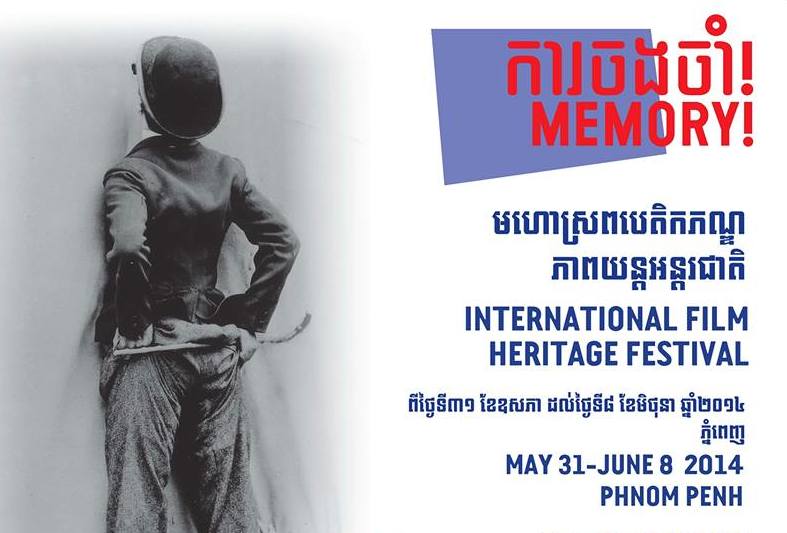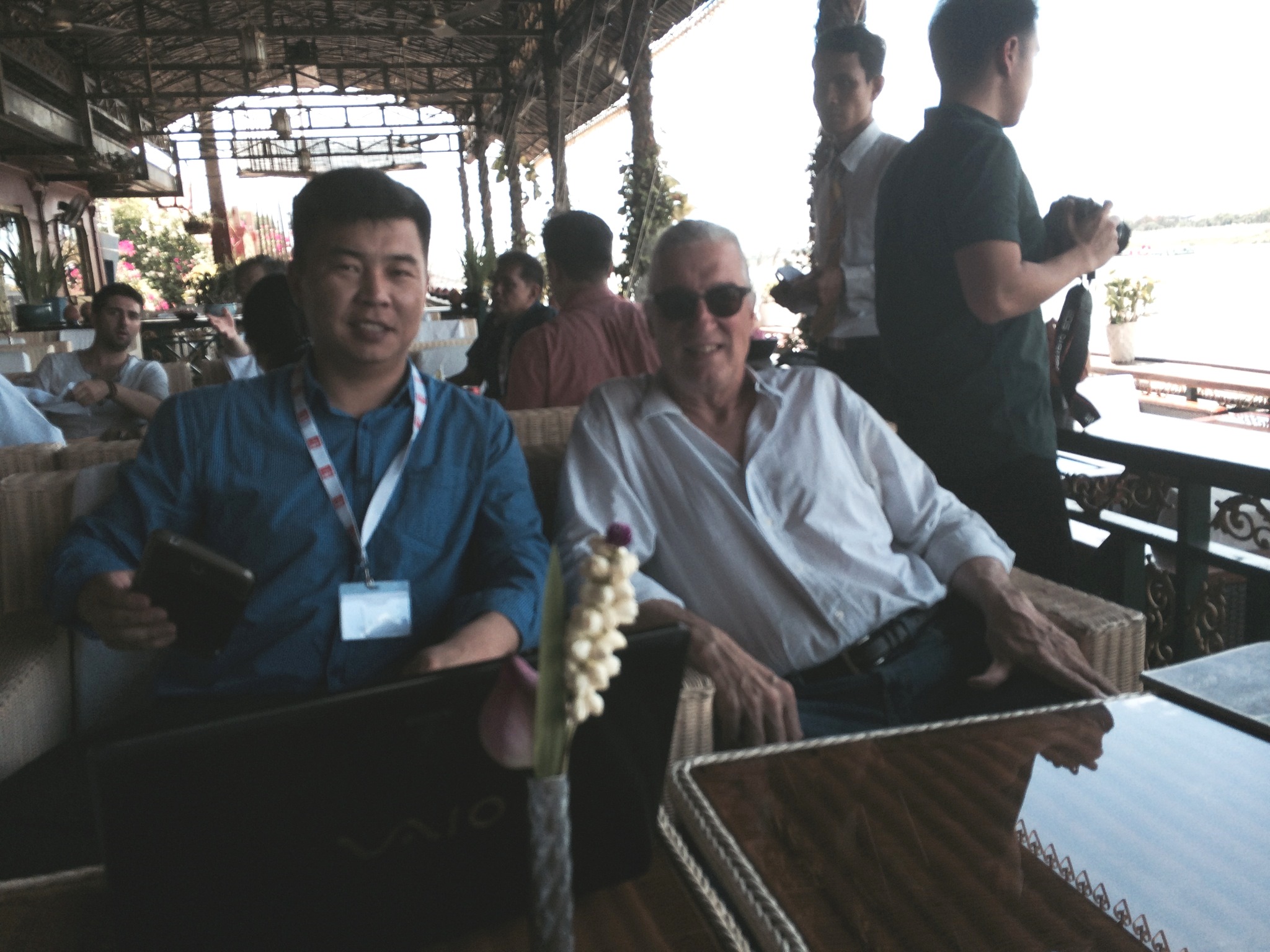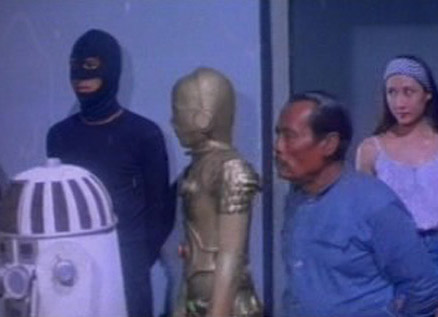
I arrived in Phnom Penh at noon and was hit by a wall of heat and humidity, but, happily, the procedures for procuring a visa on the spot were easy, cheap and quick. Once out of the airport, I travelled by "tuc-tuc" (a motorcycle-driven rickshaw) to the hotel with David Pozzi (L’Immagine Ritrovata, Bologna) and Julian, one of our hosts from Memory! International Film Heritage Festival, which has been organized for a second year by the Technicolor Foundation to support moving image preservation in Cambodia and Southeast Asia. After a brief rest in the hotel and a prolonged struggle with my tuxedo’s bow tie, I arrived at the festival’s evening opening, with Chaplin's The Circus (1928) on the program. When everyone had been seated, Catherine Deneuve arrived in a stunning red dress, followed a short time later by Norodom Sihamoni, the King of Cambodia (who had a special throne in front of the first row). I didn’t get to see much of Deneuve, except from the back, but that would change a few days later.

Next morning, we toured the National Museum of Cambodia, where a French curator/restorationist gave us a private tour and explained how they are finding pieces of priceless statues from Angor Wat and other places (during the Civil War huge numbers were stolen by thieves for sale in the West) and reconstructing them. It was a great introduction for our own film preservation conference, which started at 10 a.m. at the Alliance Française. Many of the speakers over the next five days were new and old colleagues, who had participated in the SEAPAVAA (Southeast Asia & Pacific Audiovisual Archives Association) Conference a few days earlier in Vientiane, Laos, including Chalida Uammburugit (Bangkok), Chew Tea Poa (Singapore), Akira Toshigi (Tokyo), Sam Ho (Hong Kong), Nick Newnham (Canberra), Benny Olgado (Manila), Liu Wenning (Bejing), Bilguun Ganbaatar (Mongolia, see photo), Adrian Wood (London) and Josh Harris (Champagne/Urbana).
The conference, which was attended by many Cambodian and Burmese film students (the latter flown in from Yangon), was scheduled every morning for two hours, and included panels on film collecting, preservation and programming (of which I was a speaker or chair), as well as on film heritage structures/projects and film school training. The discussions were lively, and I hope we were able to communicate to the students that film archiving is important, regardless of how small you start. Indeed, the stories from Asian archivists on the ground were heartening, even if they are suffering from chronic underfunding.
"Afternoons and evenings were spent watching festival films and my own preference was for the rare Asian films, rather than the Anglo-European classics (mostly comedies) programmed for local audiences."
 Afternoons and evenings were spent watching festival films and my own preference was for the rare Asian films, rather than the Anglo-European classics (mostly comedies) programmed for local audiences—although I did finally catch up with Happiness (1934, Aleksandr Medvedkin), a film I have been chasing for decades, ever since I saw Chris Marker’s The Train Rolls On (1973) about Medvedkin. I was particularly interested in what was billed as the earliest surviving Chinese film, Romance of a Fruit Peddler (1922, Zhang Shichuan), which was a charming comedy, although the print was an old, murky telecine transfer. China Film Archive also presented Orioles Banished from the Flowers (1947, Fang Peilin), which gave a rare glimpse of Chinese filmmaking just before the Mao revolution, but more surprising was the Mongolian feature, Before Rising Up the Rank (1965, Lodongiin Tudev), a very irreverent and funny look at ruling class structures in early 20th-century Mongolia.
Afternoons and evenings were spent watching festival films and my own preference was for the rare Asian films, rather than the Anglo-European classics (mostly comedies) programmed for local audiences—although I did finally catch up with Happiness (1934, Aleksandr Medvedkin), a film I have been chasing for decades, ever since I saw Chris Marker’s The Train Rolls On (1973) about Medvedkin. I was particularly interested in what was billed as the earliest surviving Chinese film, Romance of a Fruit Peddler (1922, Zhang Shichuan), which was a charming comedy, although the print was an old, murky telecine transfer. China Film Archive also presented Orioles Banished from the Flowers (1947, Fang Peilin), which gave a rare glimpse of Chinese filmmaking just before the Mao revolution, but more surprising was the Mongolian feature, Before Rising Up the Rank (1965, Lodongiin Tudev), a very irreverent and funny look at ruling class structures in early 20th-century Mongolia.
 But my favorite discovery was the Asian James Bond spoofs, accompanying Casino Royale (1967)and Modesty Blaise (1966), themselves spoofs. In James Band 007 (1980, Chai Nimitrchotinai), a Thai film, a local tuc-tuc driver must take over for the real 007 and save the world. Featured were R2-D2 and C-3PO (on the lam from Star Wars) as Dr. Evil’s stupid assistants. Equally outrageous was the Malaysian film, Mat Bond (1967, M. Amin & Mat Sentul), in which a local boob who still lives with his mother stumbles into an international plot and, through no fault of his own, saves the day. Both films, like the Filipino James Batman (1966, Artemio Marquez), illustrate the reception of American popular culture inSoutheast Asia and seemed almost postmodern in their playful quotations.
But my favorite discovery was the Asian James Bond spoofs, accompanying Casino Royale (1967)and Modesty Blaise (1966), themselves spoofs. In James Band 007 (1980, Chai Nimitrchotinai), a Thai film, a local tuc-tuc driver must take over for the real 007 and save the world. Featured were R2-D2 and C-3PO (on the lam from Star Wars) as Dr. Evil’s stupid assistants. Equally outrageous was the Malaysian film, Mat Bond (1967, M. Amin & Mat Sentul), in which a local boob who still lives with his mother stumbles into an international plot and, through no fault of his own, saves the day. Both films, like the Filipino James Batman (1966, Artemio Marquez), illustrate the reception of American popular culture inSoutheast Asia and seemed almost postmodern in their playful quotations.
One evening, the conference speakers were invited to the French Embassy for a dinner with Catherine Deneuve, who appeared fashionably late and mostly kept to herself, while we archivists goggled. However, I did actually get to meet the diva, when festival organizer Séverine Wemaereinvited me to take a limo to the airport with herself and Deneuve. We spoke briefly about Douglas Sirk, before she turned to write postcards. Not since getting kissed on the cheek by Audrey Hepburn have I had such a cool celebrity encounter.






 Mobile Navigation
Mobile Navigation

